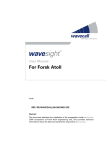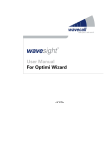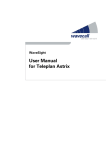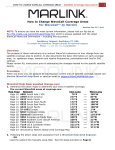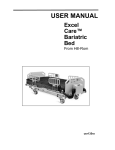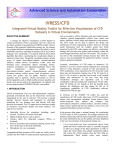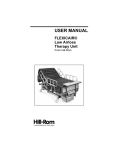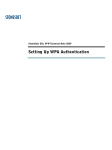Download Company Information
Transcript
User Manual For Marconi Planet EV® <1.1> REF: RP/WAVECALL/24-03-2004/KR Abstract This document describes the installation and usage of the propagation model WaveSight inside Marconi Planet EV. It is providing technical information about the data and parameters required by WaveSight. WaveSight User Manual Planet EV Company Information Address Lausanne Wavecall SA Science Park of the Swiss Institute of Technology PSE-B / EPFL 1015 Lausanne Phone +41 21 693 84 05 Fax +41 21 693 84 06 Contact Karim Rizk Email Web [email protected] http://www.wavecall.com Document History Version Revision Date 0.9 Karim Rizk October 16, 2003 0.9.1 Karim Rizk October 19, 2003 0.9.2 Karim Rizk October 20, 2003 1.0 Karim Rizk November 20, 2003 1.2 Odeh Ghawi February 02, 2004 1.3 Jürgen Eitle March 10, 2004 1.4 Jürgen Eitle March 11, 2004 1.5 Jürgen Eitle March 24, 2004 1.6 Jürgen Eitle May 17, 2004 1.7 Jürgen Eitle June 2, 2004 1.8 Jürgen Eitle June 3, 2004 1.9 Jürgen Eitle July 28, 2004 Confidential © 2003 Wavecall SA Jul-04 - Page 2/2 WaveSight User Manual Planet EV REF: RP/WAVECALL/24-03-2004/KR.................................................................................................. 1 Company Information........................................................................................................................ 2 Document History .............................................................................................................................. 2 New Features of WaveSight for version 4.0 of Planet EV.................................................................. 4 1. Introduction ................................................................................................................................. 4 2. Installation and configuration.................................................................................................... 5 2.1 Version ..................................................................................................................................... 5 2.2 Prerequisites ............................................................................................................................ 5 2.3 Installation ............................................................................................................................... 5 2.3.1 2.4 Installation procedure...................................................................................................... 5 Parameters used by WaveSight............................................................................................. 5 2.4.1 Parameters to be set for WaveSight .............................................................................. 5 2.4.2 Parameters read by WaveSight from the transmitter settings.................................. 11 2.5 Vector data (buildings and vegetation) ............................................................................... 14 2.5.1 Configuring the data...................................................................................................... 14 2.5.2 Data requirements ......................................................................................................... 14 2.5.3 Vector data format ......................................................................................................... 17 2.5.4 Shape data format:.............................................................................................................. 19 2.6 Terrain data............................................................................................................................ 20 2.6.1 Digital Terrain Height Data (DTM) ......................................................................................... 20 2.7 3. Running WaveSight .............................................................................................................. 20 WaveTune.................................................................................................................................. 22 3.1 Introduction ................................................................................................................................ 22 3.2 Running WaveTune ................................................................................................................... 22 3.3 Different optimization goals can be achieved with WaveTune ............................................ 28 4. Frequently asked questions for Planet EV.............................................................................. 29 4. Appendix I ................................................................................................................................. 29 (WaveSight error messages) .......................................................................................................... 29 5. Bibliography .............................................................................................................................. 32 Confidential © 2003 Wavecall SA Jul-04 - Page 3/3 WaveSight User Manual Planet EV New Features of WaveSight for version 4.0 of Planet EV WaveSight is now supporting non co-located sectors, i. e. sites where the sector antennas are not all at the same location. See section 2.4.2 for more information. WaveSight can now directly read the the grid file from the project directory. As a result a set of DTM files is obtained. See section 2.6 for more information. WaveSight works without the user having selected a clutter. See section 2.4.1 WaveSight can read “shape data” building files. See section 2.5.4 for more information. WaveTune is now available as a tuning model for WaveSight. See section 3. for more information. 1. Introduction WaveSight is a wave propagation prediction tool for wireless networks. It is specifically used to predict radio wave propagation for mobile communication networks in urban and suburban environments. The deployment of a cellular network is subject to tight schedules that must ensure high quality service with optimal infrastructure expenditure. WaveSight is instrumental in reducing costs and planning time, and in improving network quality as it meets prediction accuracy requirements. To achieve high prediction accuracy WaveSight uses new methods of calculation that were validated as part of thesis research conducted at the Swiss Institute of Technology in Lausanne (EPFL), Swisscom, Dutch Telecom and at Bell Laboratories of Lucent Technologies, Crawford Hill, New Jersey, USA. The inputs for WaveSight 3.6 are 1) the vector of buildings and vegetation (in case available), terrain and clutter given in raster format. Confidential © 2003 Wavecall SA Jul-04 - Page 4/4 WaveSight User Manual Planet EV 2. Installation and configuration 2.1 Version Component Version information WaveSight algorithm 3.6 Interface 1.1.9.0 (with Planet EV 4.0.1) Licensing of this release is integrated in Planet EV's licensing scheme. 2.2 Prerequisites WaveSight requires the following environment: 1. Planet EV 4.0 or higher on Windows 2000 or higher. 2. Up to 500 MB of disk space for temporary files and >= 500 MB of RAM, 1 GB is recommended. 2.3 Installation 2.3.1 Installation procedure WaveSight comes pre-installed with Planet EV, contact Planet EV support for details. To check if WaveSight is installed correctly, the following paragraphs give a brief overview over the installed WaveSight files: The WaveSight installation directory is by default "Planet EV install directory". It contains the files "wavesight.exe", " ant_db.dat". 2.4 Parameters used by WaveSight 2.4.1 Parameters to be set for WaveSight You can add a WaveSight model from Planet EV from the menu Tools->Propagation Model Editor by selecting WaveSight in the Model Type choice list. The WaveSight parameters are: A) In the window Propagation Model Editor you can set the following parameters (Figure 1) • Frequency [MHz]: The frequency • Receiver Height [m]: The receiver height above the ground. Confidential © 2003 Wavecall SA Jul-04 - Page 5/5 WaveSight User Manual Planet EV B) When clicking on Edit in the window Propagation Model Editor a window named WaveSight Parameters appears (Figure 2). The following parameters can be set: • Indoor Attenuation Factor [dB]: A penetration loss factor from outdoor to indoor. For indoor calculations, WaveSight Computes the average field on the circumference of the building and then applies a constant penetration loss. In general, we recommend the following values for penetration loss: concrete walls (with windows): 10-15 dB, wooden walls: 7 dB, metallic shielded glass: 20-40 dB • Resolution [m]: The computation resolution. • Corr. Factor Vertical [dB]: WaveSight translates this factor to a Medium Loss using the following formula: o - Medium Loss = 10 Corr. Factor Vertical/10. The Medium Loss represents an attenuation associated with a ray propagating in the vertical plane over buildings. This attenuation acts as the real part of the wave number. The higher the real part of the wave number the higher is the Medium Loss. Therefore according to the equation above the smaller the Corr. Factor Vertical the higher is the Medium Loss. This factor can be used to account for loss due to objects not represented in or missing from the geographical database. • Corr. Factor Horizontal [dB]: WaveSight translates this factor to a Medium Loss using the following formula: o - Medium Loss = 10 Corr. Factor Horizontal/10 The Medium Loss represents an attenuation associated with a ray propagating in the horizontal plane around buildings. This attenuation acts as the real part of the wave number. The higher the real part of the wave number the higher is the Medium Loss. Therefore according to the equation above the smaller the Corr. Factor Horizontal the higher is the Medium Loss. This factor can be used to account for loss due to objects not represented in or missing from the geographical database. • Corr. Factor Terrain [dB]: WaveSight translates this factor to a Medium Loss using the following formula: o - Medium Loss = 10 Corr. Factor Terrain/10. The Medium Loss represents an attenuation associated with a ray propagating in the vertical plane after diffraction from terrain (typically in open areas). This factor is only taken into account if there is no clutter associated with the point of diffraction. This attenuation acts as the real part of the wave number. The higher the real part of the wave number the higher is the Medium Loss. Therefore according to the equation above the smaller the Corr. Factor Terrain the higher is the Medium Loss. This factor can be used to account for terrain occupation when no clutter values are available. • Terrain file path: It contains the path for the terrain directory that contains the terrain data in format explained in section 2.6. Click on the Browse button adjacent to this field, and select the index.txt files associated with the terrain data. • Building data path: It contains the path for the building directory that contains the building and the vegetation data in format explained in section 2.5. Click on the Browse Confidential © 2003 Wavecall SA Jul-04 - Page 6/6 WaveSight User Manual Planet EV button adjacent to this field, and select the index.txt files associated with the vector data. • Height Relative to Ground: Check this box to indicate that vector elevation data pointed to by Vector data path is relative to ground level, otherwise they will be considered as relative to sea level. C) If the user has chosen to use clutter, then under the tab Clutter Properties in the Model Editor the user must select Depend on Projects Settings. A Clutter Property Assignment (.cpa) file, which is compatible with the clutter file, must be selected in the field Clutter Property Assignment File. Click on the Edit CPA button to adjust the value of the clutter as follows (Figure 3). • Permittivity: Is the relative permittivity assigned to the clutter. The permittivity is taken into account in the diffraction formula over the terrain. The higher the permittivity is the more energy is diffracted from the terrain • Conductivity [S/m]: Is the conductivity assigned to the clutter. The conductivity is taken into account in the diffraction formula over the terrain. The higher the conductivity is the more energy is diffracted from the terrain • Corr. Factor [dB]: represents attenuation associated with a ray propagating in the vertical plane in open area above certain clutter. In this version of the interface The feature Use Single Clutter Property is not supported. The two tabs Rain Attenuation and Advanced in Model Editor Window (Figure 1) are not considered WaveSight does not consider the first row of the clutter, which is usually named dBP_Unknown. The higher the Corr. Factors (Vertical, Horizontal, Terrain, and in the clutter properties) the lower is the resulting attenuation. . Confidential © 2003 Wavecall SA Jul-04 - Page 7/7 WaveSight User Manual Planet EV Figure 1 WaveSight propagation model main menu Figure 2 WaveSight parameters window Confidential © 2003 Wavecall SA Jul-04 - Page 8/8 WaveSight User Manual Planet EV Figure 3 Clutter Property Assignments Once you have adjusted your properties you can open the Clutter Assignments tab (see the Options menu). Here you should check, that all clutter properties from the .grc file have been assigned. This means that all entries in the clutter list (left side in Figure 4) are checked. At the same time make sure the number of entries in both lists is the same. If the reference list has more entries than the clutter list. WaveSight and WaveTune may produce unpredictable results or may not run at all. This usually is not an issue, as any clutter reference list, that is automatically generated will have the correct number of entries. Confidential © 2003 Wavecall SA Jul-04 - Page 9/9 WaveSight User Manual Planet EV Figure 4: Clutter Assignment, advanced Confidential © 2003 Wavecall SA Jul-04 - Page 10/10 WaveSight User Manual Planet EV 2.4.2 Parameters read by WaveSight from the transmitter settings From the main page (Figure 5) • The sector location coordinates X, Y for each sector. Note, that if all the sectors are located at the same place, then this is equivalent to “site location” of earlier editions of the interface. The interface now supports non co-located sectors. It is now possible for one site to have its antennas at different locations. From the Edit Sector (Figure 6) • EIRP (dBm): The equivalent isotropic radiated power (EIRP) in dBm • Antenna type: The antenna pattern • Height (m): The antenna height in meters • Azimuth: The antenna azimuth in degrees • Down-tilt: The antenna down tilt in degrees • Distance: Half the size of the square of the prediction frame • Propagation Model: The WaveSight propagation model - Confidential WaveSight is only generating masked propagation predictions. Therefore the user must check “prediction parameters by sector“ in the site editor window (Figure 5) © 2003 Wavecall SA Jul-04 - Page 11/11 WaveSight User Manual Planet EV Figure 5 Site Editor Confidential © 2003 Wavecall SA Jul-04 - Page 12/12 WaveSight User Manual Planet EV Figure 6 Sector editor Confidential © 2003 Wavecall SA Jul-04 - Page 13/13 WaveSight User Manual Planet EV 2.5 Vector data (buildings and vegetation) 2.5.1 Configuring the data Vector data is stored in ASCII format and requires three types of input files - a vector data file, an attributes file and an index file. The index file has to be named “index.txt”. Each line is containing: a vector data file name, an attribute file name, Easting Northing co-ordinates representing a bounding box around that feature and the feature name itself (7 items). Lines containing features without an attribute file are not accepted. 2.5.2 Data requirements The building data used by WaveSight is modeling the buildings’ footprint and the buildings’ height. The building data should comply with the following requirements: Confidential Requirement Explanation Identical polygons are not accepted The data set must not contain the same building twice. This is the very idea of a set. Polygons must be closed. The first and the last point in each polygon must be identical. Open "polygons" are not accepted: At least 3 distinct vertices per polygon. Also the three vertices must not be on a straight line. The dataset must not contain one or two coordinate "buildings". One vertex must belong to exactly two walls This requirement means that "Spikes" (the building outline contains a vertex which comes back on a previous vertex) are not permitted in the outline: © 2003 Wavecall SA Jul-04 - Page 14/14 WaveSight User Manual Planet EV "8-shaped buildings" (the building outline actually contains two buildings, touching each other at one coordinate) are not permitted: Each two walls can only intersect if they are successive walls belonging to the same polygons. In such a case the intersection forms the vertex. Confidential This means that Self-intersecting polygons are not allowed. © 2003 Wavecall SA Jul-04 - Page 15/15 WaveSight User Manual Planet EV Overlapping polygons are not allowed: All heights must be above local ground. It is not permitted to model "holes" as buildings below the terrain height level. An accuracy 1 m in building corner position is required The paper [2] contains a discussion of the influence of the database accuracy on prediction results. It is available on Wavecall's web site. There should not be any repeated vertices. This restriction applies to the versions before 2.2.19 of the WaveSight algorithm. The index file must contain the string "building" or vegetation It is important to set the frame coordinates correctly in the file index.txt Confidential WaveSight is only reading buildings inside these coordinates. © 2003 Wavecall SA Jul-04 - Page 16/16 WaveSight User Manual Planet EV 2.5.3 Vector data format An example of the buildings or vegetation format, with all conditions as indicated above, is shown below: Vector file Header Record Easting Northing Easting Northing Easting Northing Easting Northing Easting Northing Header Record Easting Northing Easting Northing Easting Northing The final row is terminated by a carriage return. The format of the header record is as follows: Field Position Description 1 1-5 Record Identifier (used to identify building segment in attributes file) 2 6-15 Blanks 3 16-47 32 Character description (not used, same as feature name field in index file entry) 4 48-50 Blanks 5 51-55 Record Count 00001 buildings 00005 725777.00 5031472.00 725775.00 5031468.00 725778.00 5031467.00 725780.00 5031471.00 725777.00 5031472.00 00002 buildings 00005 725783.00 5031472.00 725781.00 5031468.00 ........ Confidential © 2003 Wavecall SA Jul-04 - Page 17/17 WaveSight User Manual Planet EV The final row is terminated by a carriage return. Vector Index File An ASCII text file called index.txt contains positional information about the vector file. This file must be in the same directory as the vector data. Each row contains the following variables separated by a space: Field Description Data filename Filename of vector data file Attribute filename Filename of building attributes (heights) file Eastmin Minimum Easting value (meters) Eastmax Maximum Easting value (meters) Northmin Minimum Northing value (meters) Northmax Maximum Northing value (meters) Feature Name Name of the feature stored in the vector data file, for WaveSight this name must contain a string called either “building” or “vegetation” For example: buildings_vec.txt buildings_atr.txt 1627764 1630022 6579401 6582574 buildings The final row is terminated by a carriage return. Vector Attributes File An ASCII text file, named in the index file contains height information about the building segments contained in the vector data file. Each row contains a record, as follows: Field Position Description 1 1-5 Record Identifier (used to identify building segment in vector data file) 2 6 Delimiter <space> 3 7-19 12 Character vector segment description (not used) 4 20 Delimiter <space> 5 21-26 Vector segment height (floating point, two decimal places) Confidential © 2003 Wavecall SA Jul-04 - Page 18/18 WaveSight User Manual Planet EV 00001 buildings 010.00 00002 buildings 007.00 00003 buildings 011.00 00004 buildings 010.00 00005 buildings 006.00 00006 buildings 006.00 .... 2.5.4 Shape data format: The data should be available in ESRI Shape file format. There can be multiple Shape building vector layers, which are referenced by an index.txt file in the following way: Field Description Shape filename Filename of the shape data file Attribute name The attributes name (inside the DBF file) Eastmin Minimum Easting value (meters) Northmin Minimum Northing value (meters) Eastmax Maximum Easting value (meters) Northmax Maximum Northing value (meters) Note: Please note that the sequence of the frame area of the buildings in the index file is different from the one in vector file format. Every Shape data set (shp, shx and dbf files) take one line in the index.txt line. The first entry specifies the name of the Shape file; the second entry contains the name of the attribute inside the DBF file containing the height of the building. The following entries contain the bounding frame xmin ymin xmax ymax coordinates. Confidential © 2003 Wavecall SA Jul-04 - Page 19/19 WaveSight User Manual Planet EV 2.6 Terrain data There are two ways to specify input files for terrain data. If you leave blank the “Elevation grid file” line in the “Analyisis->Project Settings” window, then a set of DTM files will automatically be created. Otherwise the specified elevation file will be used. 2.6.1 Digital Terrain Height Data (DTM) The digital terrain height data (DTM) needed is stored in a binary format where each element of the data represents the height above sea level in meters for a square area of, for example, 50m x 50m. Each element is two bytes in size and the most significant byte is stored first. The elements are stored in one continuous array such that the size of the array in the following example would be 500 (wide) x 500 (high) x 2 (bytes per element) = 500,000 bytes. If there are pixels within the file that are outside the limits of the map, the value -9999 is stored at that location. An ASCII text file called index.txt contains positional information about each binary height file. This file must be in the same directory as the height data. The file contains one row describing each height file. Each row contains the following variables separated by a space: Field Description Filename Filename of DTM Height file Eastmin Minimum Easting value (meters) Eastmax Maximum Easting value (meters) Northmin Minimum Northing value (meters) Northmax Maximum Northing value (meters) Square Size Size of each element of the height data (meters) For example: file1.bin 100000 125000 50000 75000 50 file2.bin 125000 150000 50000 75000 50 The final row is terminated by a carriage return. In certain cases the Terrain data is available in several resolutions: typically a resolution of 20+ for an entire state or nation, and 5m for built up areas. In such areas the resolution that will be considered by WaveSight is the one associated with the entry that comes last in the index file. Therefore it is recommended in the index file to first list the lower resolution data and then the higher resolution ones. 2.7 Running WaveSight Running WaveSight is following the same procedures as running any other prediction tool in Planet EV. Confidential © 2003 Wavecall SA Jul-04 - Page 20/20 WaveSight User Manual Planet EV Each time WaveSight is called a log file named wsanalysis.err is generated. It is located in project directory. The main use of this file is to track WaveSight errors whenever they occur. This file was particularly designed to run WaveSight over a large number of sites. In case WaveSight encounters an error on one sector: Confidential - It will log the error to wsanalysis.err - A message in the Generator window will prompt the user to look at the log file - The predictions are carried out on the remaining sectors. © 2003 Wavecall SA Jul-04 - Page 21/21 WaveSight User Manual Planet EV 3. WaveTune 3.1 Introduction Planet EV is offering a model tuning feature. Here the term model tuning means the process of adjusting the parameters of the WaveSight model in order to produce predictions that are as accurate and realistic as possible. The tuning is usually performed using measured signal strength data collected during surveys. The parameters adjusted in this way are generally the clutter absorption loss values, the Corr. Factor Vertical, the Corr. Factor Horizontal, and the Corr. Factor Terrain. 3.2 Running WaveTune If you are new to model tuning please read the corresponding entries in Planet EV’s help system. The following lines assume, that you are familiar with the basic functionalities of Planet EV concerning model tuning. Follwing is a step by step description of how to set up a WaveTune session from within Planet EV. Before you start using the tuning capabilities make sure to create a C:\temp directory (i. e. a directory named “temp” on the C: drive). WaveTune needs this directory being present, otherwise it won’t run. 1. In the project explorer open two windows. In one window chose the category Sites and in the other chose the category Operational Data. In the Sites window expand the sites you want to apply tuning to, and in the other expand the Surveys (under Survey Manager, and the Surveys RSSI entry or whatever surveys you are using). At the end of this step your Project explorer should look like in Figure 7. In our example let’s tune sector 1 of site 1001 using survey survey_1001_1_ptp. Confidential © 2003 Wavecall SA Jul-04 - Page 22/22 WaveSight User Manual Planet EV Figure 7: Project explorer 2. Right click on the survey you want to tune, and from the pop up menu choose Model Tuning. When you are done you should have the Model Tuning window on the screen. In the Model to tune line choose the .dpm file corresponding to the WaveSight Model you want to tune. Typically this would be the same name that you used to run predictions on the corresponding sector. In the Model tuner line WaveTune is automatically chosen as the model tuner. In the New Model name enter the name of the model that is defined by the parameters resulting from tuning the model chosen in step a. In our example the Model to tune is WaveSight_tune, and the New Model name is Confidential © 2003 Wavecall SA Jul-04 - Page 23/23 WaveSight User Manual Planet EV WaveSight_adjusted. The process will create a new model file called WaveSight_adjusted.dpm and a clutter assignment file called WaveSight_adjusted.cpa. Press Edit Tuner to open the WaveTune Parameters window. 3. In the WaveTune Parameters window (Figure 8) 4. Figure 8: WaveTune Parameters window the initial values for the vertical, horizontal and terrain correction factors can be entered. The increments have a fixed value, and cannot be edited by the user. You can choose which value to include in tuning by simply checking or un-checking the corresponding box in the Select column. If you want to include clutter in the tuning process, you have to check the Use Clutter Tuning check box. Then press the Edit Clutter button. This opens the Confidential © 2003 Wavecall SA Jul-04 - Page 24/24 WaveSight User Manual Planet EV Clutter Tuning Parameters Window. This window looks like this: Figure 9: Clutter Tuning Parameters After setting the clutter parameters, press OK to close the clutter window, then press OK to close the WaveTune parameters window and finally press OK to start the tuning process. Important: Do not use the unclassified_sat clutter, it will be ignored. 5. At this point two windows will open and WaveTune will start to run. One window is just indicating which model is being tuned and the total time elapsed since the the start of the tuning process (Figure 10). Do not use the Cancel button in this window to stop the tuning process. It will close the window, but not actually stop the tuning process. See the next paragraph on how to properly abort tuning. In the other window you will see print outs of WaveTune progressing (Figure 11). On each iteration WaveTune indicates the current error value, and the last “best error” value. If a new “best error” value is found, then this will be indicated. In order to abort the tuning process, press the STOP button. Confidential © 2003 Wavecall SA Jul-04 - Page 25/25 WaveSight User Manual Planet EV Figure 10: Tuning progress Confidential © 2003 Wavecall SA Jul-04 - Page 26/26 WaveSight User Manual Planet EV Figure 11: WaveTune progress In order to abort the tuning process, press the STOP button. At the end of the tuning process the window will stay open. You will notice when the program is finished, if you see several lines that show values for Airloss etc. In the latter press the Close button, you will be prompted for viewing the tuning report. It is important, that you stick to this sequence, as otherwise you will not see the tuning report. 6. After tuning a new propagation model file WaveSight_adjusted.dpm and a new clutter assignment file WaveSight_adjusted.cpa is created. You can now use this new model to run predictions. To do so in the Site Editor simply choose the WaveSight_Adjusted.dpm as new propagation model for the sector you want to use it on. Confidential © 2003 Wavecall SA Jul-04 - Page 27/27 WaveSight User Manual Planet EV 3.3 Different optimization goals can be achieved with WaveTune WaveTune is offering a great deal of flexibility in achieving your tuning goals. Basically any one parameter can be included or excluded from the tuning process. This way you can reduce calculation time, and also include your knowledge of the propagation environment. Particularly the user can choose if the tuning should mainly concentrate on reducing the standard deviation or the mean error or both at the same time. Clutter can be included or excluded depending on whether you have a clutter file or not. Different clutter properties can be included in the tuning or left at their original value. This gives you the possibility to literally fine tune your model. If you are new to model tuning with WaveTune, then here are some recommendations: 1. Use RMS as the tuning option (cf. Figure 8) Tuning options explained: On every iteration WaveTune is comparing the prediction with the measured values. The error is characterized by two numbers, the arithmetic mean of the error and the standard deviation (std) of the error. These two numbers can be combined to form the root mean square (rms) of the error. The following relation holds: rms2 = std2 + mean2. For the tuning process this means: • Use the RMS minimizing option to take into account the mean of the error, and the standard deviation of the error. This is the recommended option. • Use the MEAN option, if you just want to minimize the mean of the error. Using this option WaveTune disregards the standard deviation. • Use the STD option if you just want to minimize the standard deviation of the error. Using this option WaveTune disregards the mean. 2. Chose all the correction factors (cf. Figure 8). Chose either the default values to obtain fast convergence or the values, that correspond to the model you start with. The correction factors have the following meaning: • Corr. Factor Vertical represents an attenuation associated with a ray propagating in the vertical plane over buildings. It significantly influences propagation in built up areas. • Corr. Factor Horizontal represents an attenuation associated with the ray propagating in the horizontal plane, mainly for propagation around buildings. • Corr. Factor Terrain represents an attenuation associated with the ray propagating in the vertical plane over terrain. It significantly influences propagation in open areas 3. Use the minimum number of clutter properties(cf. Figure 9). This means that you should try to get as much information as you can get on the clutter properties, and assign them in the WaveSight_tune.dpm file (the model file before tuning). The more clutter you select for tuning, the longer the tuning process will take. On a 1.5 GHz Pentium 4 machine a survey route with 1000 points an area of 4 km2, and a resolution of 50m might run for 5 hours to tune the three correction factors and one clutter property. A good way to choose the clutter to tune is to open the survey in the Survey to Grid comparison window. Chose only those clutter types that have a nonzero number of points. You can further reduce the number of clutter classes to tune by obtaining local knowledge. E.g. water in your area has a known absorption factor, so does concrete etc. Note: WaveTune is directly using the clutter grid of Planet EV. Confidential © 2003 Wavecall SA Jul-04 - Page 28/28 WaveSight User Manual Planet EV Important: There is a limit of 14 different clutter properties that are simultaneously tunable. This limit is there to keep computation times reasonable. Usually there are no more than about 10 different clutter types in the area you want to tune. This limit is also there to guide the user to a sensitive approach to tuning. 4. In dense urban areas, do not use clutter tuning, i. e. uncheck the Clutter Tuning checkbox (cf. Figure 8). In open non-urban areas, just use clutter tuning and do not select the Corr. factors. In a transition zone you would have to use both. 4. Frequently asked questions for Planet EV Question Answer Question Answer Is the DTM format identical to the Planet format, i.e. the first element in the file corresponds the Northwest corner and the last element to the Southeast corner and the elements are ordered west to east? Yes. Question Answer What value should I use for the rain attenuation? WaveSight do not use this parameter in Planet EV. Question What is the advantage of using Planet DMS format for the terrain data and not Planet EV format? The Planet EV format for the terrain data allow a maximum of two different terrain resolutions; while using the DMS format for WaveSight allows to use unlimited number of different resolutions. Answer 4. Is there a way to specify a specific index file in the Planet EV propagation model editor, edit, browse for index file path? WaveSight will only read the index.txt file and not care about the others. Appendix I (WaveSight error messages) Errors WSERR1: You cannot have an IndexTerrDir and a TerrainFile. Please check infiles.txt Confidential Explanations IndexTerrDir is a key word in infiles.txt that indicates the directory of a specific type of terrain format. © 2003 Wavecall SA Jul-04 - Page 29/29 WaveSight User Manual Planet EV TerrainFile is a key word in infiles.txt that indicates the path for the file WaveSight type of terrain. Therefore it is not possible to have both keywords in infiles.txt IndexBldgDir is a key word in infiles.txt that indicates the directory of specific type of building format. WSERR2: You cannot have an IndexBldgDir and a BldgFile. Please check the inputs.txt file BldgFile is a key word in infiles.txt that indicates the path for the file WaveSight format of buildings. Therefore it is not possible to have both keywords in infiles.txt WSERR3: hori directory not found In the WaveSight directory a sub directory named hori must exist. On PC platform this directory is created automatically On UNIX platform this directory must be created manually WSERR4: Insufficient memory WSERR5: This version cannot handle full 3D The CompType in comp.txt is set to 2. WSERR6: The antenna pattern is given with a resolution higher than half degree WSERR7: The pattern of the specified antenna is not listed in the antenna file The file which contains all antenna patterns, (it is specified via the keyword AntFile in infiles.txt) does not contains the antenna pattern specified in transmitter WSERR8: An antenna file name must be provided The AntPtrn key word in the transmitter file indicates a pattern, but infiles.txt does not contain the path to the file where this pattern can be found WSERR9: Buildings elevation is relative to ground and there is no terrain file Confidential WSERR10: No frame file is given It is mandatory to indicate in the infiles.txt a frame file with the key word FrameFile WSERR11: Error in frame file: east x >= west x The frame file indicated by the key word FrameFile in infiles.txt, must contains the x of the south east corner, the y of the south east corner, then the x of north west, and then the y of the north west corner. WSERR12: Error in frame file: south y >= north y The frame file indicated by the key word FrmFile in infiles.txt, must contain the x of southeast corner, the y of the southeast © 2003 Wavecall SA Jul-04 - Page 30/30 WaveSight User Manual Planet EV corner, then the x of northwest, and then the y of the northwest corner. Confidential WSERR13: Error in the index file: east x >= west x The index file of terrain heights of specific format indicated by the key word IndexTerrDir, must contain the x of south east corner, the y of the south east corner, then the x of north west, and then the y of the north west corner WSERR14: Error in the index file: south y >= upper y The index file of terrain heights of specific format indicated by the key word IndexTerrDir, must contain the x of south east corner, the y of the south east corner, then the x of north west, and then the y of the north west corner WSERR15: No index directory for terrain is given The index file of terrain heights of specific format indicated by the key word IndexTerrDir must be given in infiles.txt. Buildings are by default assumed to be given relative to ground level, except if the flag Is2Ground is set to 1 in comp.txt WSERR16: This version can only handle Profile or Horizontal propagation In comp.txt CompType was set to a value different from 1 (horizontal computation) or 3 (combination of vertical and horizontal plane computation) WSERR17: No Tx file is given For propagation prediction a transmitter file must be given in infiles.txt using the key word TxFile WSERR18: No index directory for buildings is given When running with a specific type of buildings, the directory that contains the index.txt file must be given in infiles.txt via the key word IndexBldgDir WSERR19: Null sized segment: ... It indicates that a null sized segment was encountered in the course of the execution. For instance, this message occurs when reading the building files and a null sized wall exists in the building file. © 2003 Wavecall SA Jul-04 - Page 31/31 WaveSight User Manual Planet EV 5. Bibliography [1] Karim Rizk: Propagation in micro-cellular and small cell urban environment, Thesis #1710 (1997), Swiss Federal Institute of Technology of Lausanne [2] K. Rizk, J.F. Wagen, F. Gardiol:Influence of database accuracy on twodimensional ray-tracing-based prediction in urban microcells, IEEE Trans. Veh. Technol., vol. 49, no. 2, March 2000, pp. 631-642. [3] Planet EV RF Planning Software, user manual. Confidential © 2003 Wavecall SA Jul-04 - Page 32/32
































